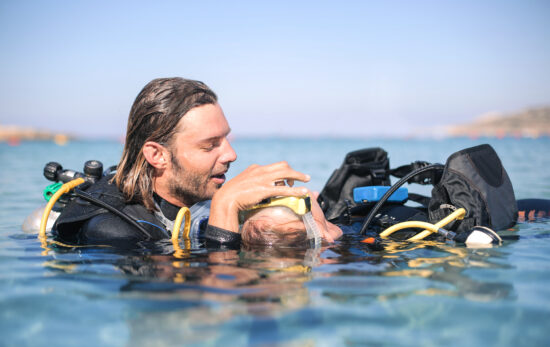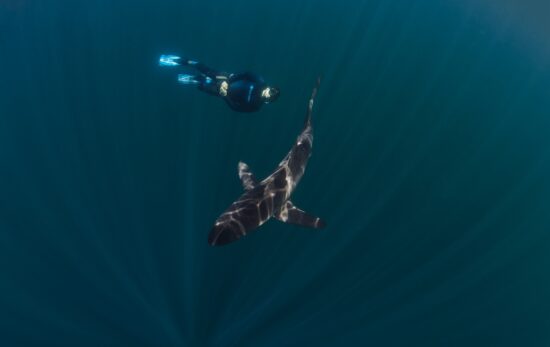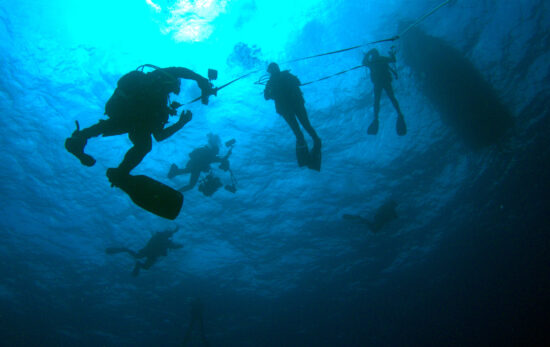Tucked away on the other side of some formidable mountain passes (still closed in June this year due to snow) and long road tunnels sits the Italian part of Switzerland – The canton of Ticino.
The change from one side of the mountains to the other can be drastic, not just from the linguistic point of going from German to Italian. But also climatic, 7c and light snow on one side and 15mins drive later 22c and sunshine on the other.
The 1st weekend in June saw me driving in search of the Verzasca valley, for a dive spot that not many people outside a small part of Europe know about.
The more dedicated James Bond fans will know that the 220m high dam at the head of the valley often used for bungee jumping also featured in the Bond film Goldeneye. But this was not my final destination, so I drove further up the valley to the small village of Lavertezzo which would be my base for the next 2 days of diving.
PADI River and Current Diver Distinctive
I had originally planned this trip for September last year, but bad weather meant the it was posponed till after most of the snow had melted.
[wzslider]
The beauty of the river running through the valley hides its dangers, so to learn how to dive it safely I was taking part in a River and Current diver course. The first lesson was to learn how to observe the river and the current, and with a dive sport as stunning as this it was a pleasure. The dangers of the river lie in the strong currents that can be present and the white water, rapids and waterfalls they can pull you into. After consulting the up to date hydro data and weather conditions we could get ready for our first days diving. It is important when making your dive plan to take into consideration weather further up the mountains or valley. Rain further up stream can easily lead to dangerous conditions further down, so be informed as your first step of dive planning.
Our first 2 dives were at the picturesque setting of the Roman bridge, and after carrying all our equipment down to the river side, we took a moment to complete a site briefing and conditions check. Once kitted up (the water was 8c so even though I used a wetsuit a drysuit is recommended) we set about our first pre dive task. Setting a cross river safety line at a point before any rapids and a guide line on the river bed for returning divers to find the entry and exit point.
Splitting the group into two enabled us to always have people available to help any diver needing to use the safety line.
As I was in the 2nd group to enter the water I was able to get up to date information of the current conditions from the 1st group. The Roman bridge site was around 6m deep (this varies depending on volume of water flowing) and being able to look up through the water at the bridge and the tourists on the bridge is an amazing experience. After the bridge the current gets stronger and using a zigzag dive pattern we tried to make the most out of flat spots to conserve energy. After much finning we decided to turn around and the return to the exit point was much less demanding as we went with the current. Each dive lasted about 20mins.
The 2nd day and the last dive was further down the river at the Amsler pool (named after famous underwater photographer Kurt Amsler) . As there had been rain overnight the current was stronger but still within safe limits. Again safety lines where placed and we split into two groups. The Amsler pool requires a long clamber down to the river but the dive is longer and has more area to explore with a small water fall at one end and rapids at the other.
Both dive sites are amazing for clearness of the water, even at this time of year when lots of debris from the snow melt is in the water. Its certainly one of the more unusual dive sites I’ve been to and I would certainly recommend Google-ing Verzasca diving to see some amazing underwater pictures of the location that my GoPro shots could not match.
I dived with Scubalino a Swiss PADI center but there are a number of others that also offer this course in the area, check out our dive store locator for more information on PADI centers in Switzerland and Italy.
[googleplusauthor]



